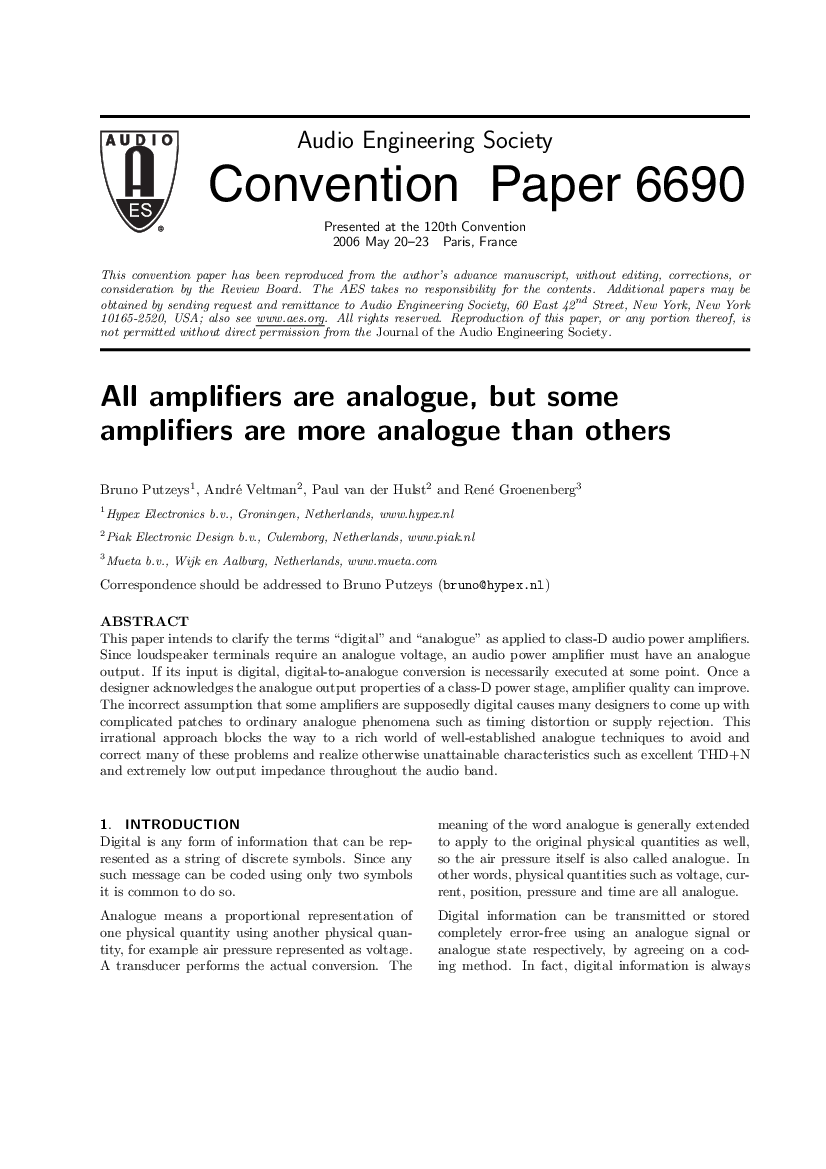Home / Publications / E-library page
You are currently logged in as an
Institutional Subscriber.
If you would like to logout,
please click on the button below.
Home / Publications / E-library page
Only AES members and Institutional Journal Subscribers can download
This paper intends to clarify the terms "digital" and "analogue" as applied to class-D audio power amplifiers. Since loudspeaker terminals require an analogue voltage, an audio power amplifier must have an analogue output. If its input is digital, digital-to-analogue conversion is executed at some point. Once a designer acknowledges the analogue output properties of a class-D power stage, amplifier quality can improve. The incorrect assumption that some amplifiers are supposedly digital, causes many designers to come up with twisted digital patches to ordinary analogue phenomena such as timing distortion or supply rejection. This irrational approach blocks the way to a rich world of well-established analogue techniques to avoid many of these problems and realize otherwise unattainable characteristics such as excellent THD+N and extremely low output impedance throughout the audio band.
Author (s): Groenenberg, René; Putzeys, Bruno; van der Hulst, Paul; Veltman, André
Affiliation:
Hypex Electronics B.V.; Mueta b.v.; Piak Electronic Design b.v.
(See document for exact affiliation information.)
AES Convention: 120
Paper Number:6690
Publication Date:
2006-05-06
Import into BibTeX
Session subject:
Signal Processing; High Resolution Audio
Permalink: https://aes2.org/publications/elibrary-page/?id=13494
(243KB)
Click to purchase paper as a non-member or login as an AES member. If your company or school subscribes to the E-Library then switch to the institutional version. If you are not an AES member Join the AES. If you need to check your member status, login to the Member Portal.

Groenenberg, René; Putzeys, Bruno; van der Hulst, Paul; Veltman, André; 2006; All Amplifiers are Analogue, but Some Amplifiers are More Analogue than Others [PDF]; Hypex Electronics B.V.; Mueta b.v.; Piak Electronic Design b.v.; Paper 6690; Available from: https://aes2.org/publications/elibrary-page/?id=13494
Groenenberg, René; Putzeys, Bruno; van der Hulst, Paul; Veltman, André; All Amplifiers are Analogue, but Some Amplifiers are More Analogue than Others [PDF]; Hypex Electronics B.V.; Mueta b.v.; Piak Electronic Design b.v.; Paper 6690; 2006 Available: https://aes2.org/publications/elibrary-page/?id=13494
@article{groenenberg2006all,
author={groenenberg rené and putzeys bruno and van der hulst paul and veltman andré},
journal={journal of the audio engineering society},
title={all amplifiers are analogue, but some amplifiers are more analogue than others},
year={2006},
number={6690},
month={may},}